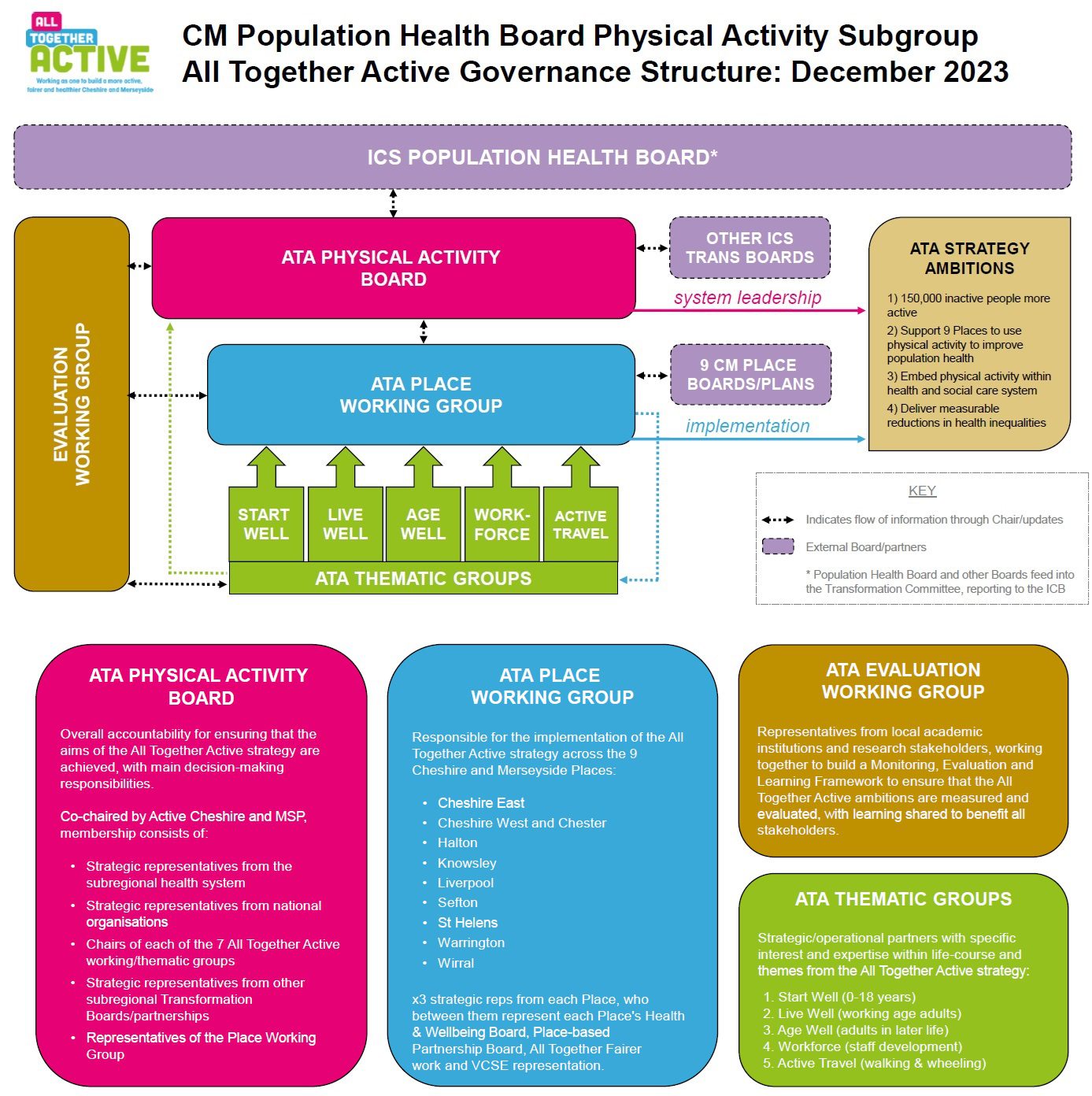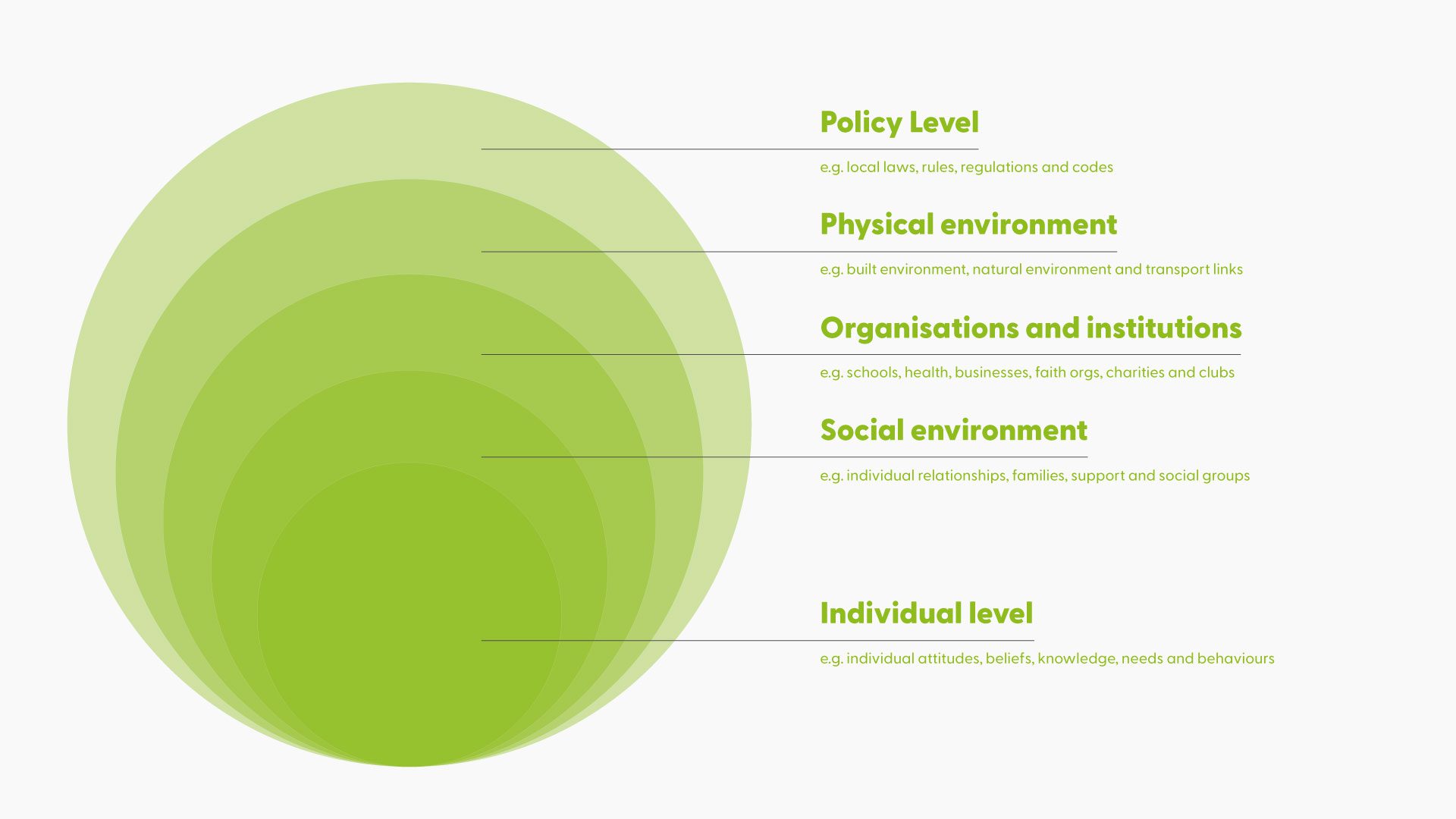Making it happen
Whole-system Working
Sources of influence include:
The individual themselves
Social environment
Family, friends, support groups, social networks, social norms within their relationship groups.
Organisations and institutions
Schools, GPs and health and social care, businesses, charities, faith organisations, clubs.
Physical environments
The built environment, access to the natural environment, transport links.
Policy
National and local strategies, budgets, laws, rules, regulations, codes.
Partnerships and Collaboration
“Activity-related budgets go much further when we collaborate and pool funding than when we spend separately. For example, at the Liverpool City Region Combined Authority, we have capital money to build walking and cycling routes. We’ll get better value and benefit more people if we can align this with funds for cycle training and behaviour change, with programmes that get people walking or cycling as part of rehabilitation or social care support, and with projects looking to make walking and wheeling the default for home to school travel.”
Huw Jenkins, Lead Officer – Transport Policy, Liverpool City Region Combined Authority
Place-Based Frameworks
A framework (defined by each Place as a strategy, action plan or model) will map audiences of interest and planned activities to determine scale and need. Frameworks will be determined by research & insight and capitalise on common emerging opportunities, looking at where the greatest impact can be achieved in various environments across the full life course. This work will include recognising where inactive people may fall through gaps and finding ways to identify and prevent this.
“I think it would be useful for it to be explicitly agreed as a priority in each of the nine Places, because then organisations are held to account for delivering something against this strategy. I think that’s really important as there are lots of priorities at the moment…Part of that then, for the next step…is a really clear plan in terms of what it actually is that we’re going to deliver against this strategy.”
How system elements fit together:
Abbreviations
PA physical activity. ICS Integrated Care System. ICB Integrated Care Board. ICP Integrated Care Partnership.
Click here to view an explainer of the role of ICSs, ICBs and ICPs.
System Leaders
A System Leader can be anyone passionate about using physical activity to improve health and who is committed All Together Active goals. They may be from an organisation or from the community. Individuals taking on a System Leader role must be able to allocate dedicated time to the task.
The strategy creates three levels of System Leader: Physical Activity Subregional System Champions, Physical Activity Local System Champions and Physical Activity System Ambassadors. A core network of Subregional System Champions is already in place, and has been co-ordinating engagement to inform and develop the strategy.
Physical Activity Local System Champions
Role: Drive development of the system approach within their Place at a strategic level
Example activities:
- Identify opportunities where physical activity can support local health priorities
- Take part in Place-based planning
- Support others to implement initiatives
- Act as a catalyst for local engagement
- Support learning within their Place and work with Subregional
- Champions to build and share knowledge
Physical Activity Subregional System Champions
Role: Coordinate things that can be best done at subregional level
Example activities:
- Lead on influencing national policy
- Take part in subregional planning
- Coordinate shared training
- Consolidate learning to give overall sense of how the subregion is doing
- Support Places and facilitate collaboration between them
Physical Activity System Ambassadors (both regional and local)
Role: Advocate for physical activity in the course of their day to day work
Example activities:
- Identify opportunities to embed physical activity in programmes and processes
- Support learning and evaluation to embed emerging thinking in their work context
- Represent their organisation, advocating for physical activity as a tool for better physical and mental health
- At times, take part in more in-depth activities in support of All Together Active
Behavioural Enablers
Making the case for physical activity to partners
Find out more
Investing in the system approach
Find out more
Local ownership
Find out more
Community engagement & co-creation
Find out more
Deprived neighbourhoods
Find out more
Promoting positive experiences of physical activity
Find out more
Strategy governance
The framework of System Leaders will be overseen by a clear governance structure led by Strategy Sponsor, Professor Ian A Ashworth (Director of Population Health for NHS Cheshire and Merseyside, and Chair of the NHS Cheshire and Merseyside Population Health Board).
Strategy Accountable Body: Physical Activity Board of the Population Health Board
Strategy Project Lead: Active Cheshire & MSP
Local Ownership/Governance to be determined in each of the 9 Places
Since 2020, the Population Health Physical Activity Board has been accountable to guide the development of this strategy. The Active Partnerships for the subregion, Active Cheshire and MSP, were appointed project leads for the development of the strategy and co-chairs of the Board.
Underneath the Physical Activity Board sits a network of working and thematic groups that guide, inform and implement the All Together Active strategy:

Funding and Resourcing
“Spare funding is hard to come by, so this work will not get done if we wait for a major investment.”
Feedback from the Engagement process
Instead, System Leaders will drive the creation and implementation of plans for building capacity and aligning collective budgets, funding bids and workstreams.
Test, learn and scale up
Measuring Impact
- Direct cost savings, such as falls prevention and reductions in serious mental health referrals.
- Improvements in both individual and community wellbeing.
- How the strategy is supporting the Marmot Indicators in reducing local health inequalities.
- The effectiveness of subregional support for Places
This will require both qualitative and quantitative data: facts, figures, individual stories, and information on how processes are performing.
Traditional evaluation methods may not always be effective in this dynamic environment. However, we will aim for measurements to be as consistent as possible between Places, audiences, environments and activities.
To achieve this, we will use best practice evaluation approaches from health and social care as the basis of our approach, producing an All Together Active Monitoring and Evaluation Framework. By aligning methods with existing local measures and using the core themes from the strategy, we will enable Places to assess whether physical activity is being used to its full potential. Though complete consistency will not always be achievable, we will work together flexibly to generate insight which is fit for purpose and helps answer the big questions.
The Road Map
Get Involved
If your organisation would like to be involved in progressing the work at a local or a subregional level then get involved today!

